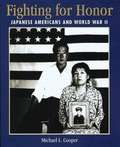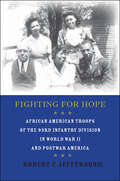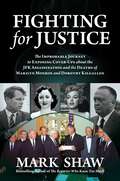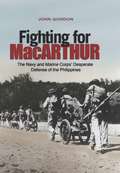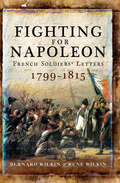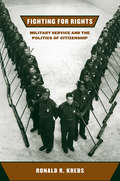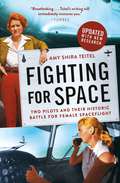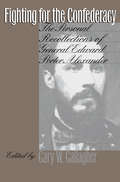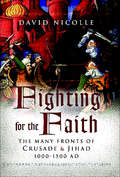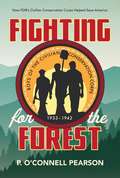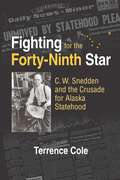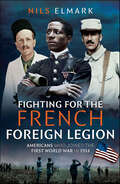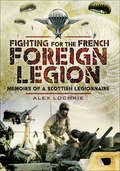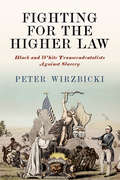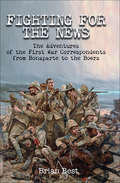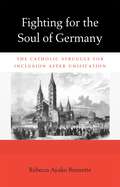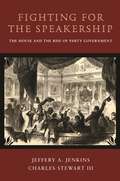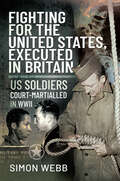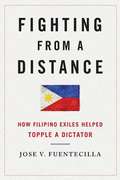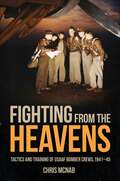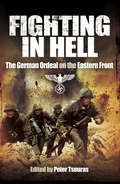- Table View
- List View
Fighting for Honor: Japanese Americans and World War II
by Michael L. CooperAn account of Japanese Americans in World War II, based mainly on diaries, autobiographies, and the military records of the 442nd Regimental Combat Team, which was known as the Purple Heart Battalion because of its bravery. After the attack on Pearl Harbor in 1941, all people on the West Coast of Japanese heritage, whether resident aliens or citizens, were forced to move into internment camps. But 1,200 young men from the camps, along with 10,000 other GIs of Japanese heritage, became some of the most decorated soldiers in the war as part of the 442nd. Author Michel L. Cooper tells of the remarkable bravery of these Nisei soldiers, whose heroism in battles in Europe contrasted with the prejudice that Japanese Americans faced at home.
Fighting for Hope: African American Troops of the 93rd Infantry Division in World War II and Postwar America (War, Society, Culture Ser.)
by Robert F. Jefferson“A rigorously researched, richly etched re-creation of the formation of the all-black Ninety-third Infantry Division, which fought in the Pacific theater.” —Journal of American HistoryThis fascinating history shows how African-American military men and women seized their dignity through barracks culture and community politics during and after World War II.Drawing on oral testimony, unpublished correspondence, archival records, memoirs, and diaries, Robert F. Jefferson explores the curious contradiction of war-effort idealism and entrenched discrimination through the experiences of the 93rd Infantry Division. Led by white officers and presumably unable to fight—and with the army taking great pains to regulate contact between black soldiers and local women—the division was largely relegated to support roles during the advance on the Philippines, seeing action only later in the war when U.S. officials found it unavoidable.Jefferson discusses racial policy within the War Department, examines the lives and morale of black GIs and their families, documents the debate over the deployment of black troops, and focuses on how the soldiers’ wartime experiences reshaped their perspectives on race and citizenship in America. He finds in these men and their families incredible resilience in the face of racism at war and at home and shows how their hopes for the future provided a blueprint for America’s postwar civil rights struggles.Integrating social history and civil rights movement studies, Fighting for Hope examines the ways in which political meaning and identity were reflected in the aspirations of these black GIs and their role in transforming the face of America.“A marvelous book.” —Annals of Iowa
Fighting for Hope: African American Troops of the 93rd Infantry Division in World War II and Postwar America (War/Society/Culture)
by Robert F. JeffersonThis fascinating history shows how African-American military men and women seized their dignity through barracks culture and community politics during and after World War II.Drawing on oral testimony, unpublished correspondence, archival records, memoirs, and diaries, Robert F. Jefferson explores the curious contradiction of war-effort idealism and entrenched discrimination through the experiences of the 93rd Infantry Division. Led by white officers and presumably unable to fight—and with the army taking great pains to regulate contact between black soldiers and local women—the division was largely relegated to support roles during the advance on the Philippines, seeing action only later in the war when U.S. officials found it unavoidable. Jefferson discusses racial policy within the War Department, examines the lives and morale of black GIs and their families, documents the debate over the deployment of black troops, and focuses on how the soldiers’ wartime experiences reshaped their perspectives on race and citizenship in America. He finds in these men and their families incredible resilience in the face of racism at war and at home and shows how their hopes for the future provided a blueprint for America’s postwar civil rights struggles.Integrating social history and civil rights movement studies, Fighting for Hope examines the ways in which political meaning and identity were reflected in the aspirations of these black GIs and their role in transforming the face of America.
Fighting for Justice: The Improbable Journey to Exposing Cover-Ups about the JFK Assassination and the Deaths of Marilyn Monroe and Dorothy Kilgallen
by Mark Shaw&“Investigative reporting at its best. Mark Shaw&’s original work into the questionable deaths of Marilyn Monroe and Dorothy Kilgallen is now focused on the many unanswered questions left by the Warren Commission&’s inquiry into the JFK assassination. Fighting for Justice has to be read.&” —Nicholas Pileggi, author of Wiseguy and Casino Packed with shocking new evidence, Fighting for Justice exposes the cover-ups of the JFK assassination and the murders of Dorothy Kilgallen and Marilyn Monroe, while revealing for the first time the corrupt inner workings of the Warren Commission based on the firsthand &“whistleblower&” account of an actual Commission member never identified before.How does an explosive &“whistleblower&” account from a Warren Commission (WC) member never identified before destroy once and for all the biggest lie in American history, the &“Oswald Alone&” theory? On what basis did the member admit, &“It&’s more than Oswald. There is internal corruption on the Commission. I do not agree with the Report&”? Is the &“whistleblower&” the same one who surreptitiously passed Jack Ruby&’s WC testimony to journalist Dorothy Kilgallen prior to its release date? And how did President Lyndon Johnson and J. Edgar Hoover strong arm the commission to prevent any investigation of the truth about who killed JFK and why? Based on fifteen years of research, answers to these questions and more are uncovered in Fighting for Justice, bestselling author and noted historian Mark Shaw&’s improbable journey to exposing cover-ups of the JFK assassination while proving Marilyn Monroe and Kilgallen were murdered.
Fighting for MacArthur
by John GordonAs the only single-volume work to offer a full account of Navy and Marine Corps actions in the Philippines during World War II, this book provides a unique source of information on the early part of the war. Based on a rich collection of American and newly discovered Japanese sources, it is filled with never-before-published details about the fighting, including a revealing discussion of the buildup of tensions between Gen. Douglas MacArthur and the Navy that continued for the remainder of the war.Gordon describes in considerable detail the unusual missions of the Navy and Marine Corps in the largely Army campaign, where sailors fought as infantrymen alongside their Marine comrades at Bataan and Corregidor, crews of Navy ships manned the Army's heavy coastal artillery weapons, and Navy submarines desperately tried to supply the men with food and ammunition. Indeed, this book gives the most detailed account ever published of the Japanese bombing of the Cavite Navy Yard outside Manila on the third day of the war-the worst damage inflicted on a U.S. Navy installation since the British burned the Washington Navy Yard in 1814. It also closely examines the surrender of the 4th Marines at Corregidor, the only time in history that the U.S. Marine Corps lost a regiment in combat. To provide readers with a Japanese perspective of the fighting, Gordon draws on the recently discovered diary of a leader of the Japanese amphibious assault force that fought against the Navy's provisional infantry battalion on southern Bataan, and he also makes full use of the U.S. ship logs and the 4th Marine unit diary that were evacuated from Manila Bay shortly before U.S. forces surrendered.
Fighting for Napoleon's Army in Russia: A POW's Memoir
by C.J. WagevierIn 1812 the French emperor Napoleon decided to invade Russia. For this purpose, he gathered an army of half a million men and women, consisting of soldiers from all nationalities, including French, German and Italian. Serving in this army was Carel Johannes Wagevier, an officer in the 125th Regiment of the Line, which was staffed by mostly Dutch soldiers. Full of confidence, they went to war and began the long journey to the East. What followed was a horrific expedition deep into the Russian interior, a chaotic retreat, and captivity. Just like his fellow soldiers, Wagevier endured the cold, the stresses of combat, and the hunger that besieged the army. After fighting at the battle of Berezina in November 1812, he was taken prisoner and transported all the way to the Russian interior. In 1814 he and his remaining fellow officers were released, and together they started the journey back home. During his travels across Russia, he made notes of events that occurred or meetings that seemed memorable, including ones of unexpected generosity as well as sudden cruelty. These notes were later expanded into his memoir and published in 1820. Now, for the first time ever, they have been translated into English, providing a unique and fascinating insight into the life of a solider in Napoleon’s army.
Fighting for Napoleon: French Soldiers' Letters, 1799–1815
by Bernard Wilkin René WilkinTrue, first-hand accounts of combat and soldiering from the men who fought for Napoleon Bonparte and the First French Empire: &“Fascinating stuff&” (Stuart Asquith, author of Military Modelling). The French side of the Napoleonic Wars is often presented from a strategic point of view, or in terms of military organization and battlefield tactics, or through officers&’ memoirs. Fighting for Napoleon:French Soldiers&’ Letters, 1799–1815, based on more than sixteen hundred letters written by French soldiers of the Napoleonic armies, shares the perspectives and experiences of the lowest, ordinary ranks of the army who fought on the frontlines. Authors Bernard Wilkin and René Wilkin provide an informative read of common soldiers&’ lives for military and cultural historians as well as a fascinating counterpoint to the memoirs of Cpt. Jean-Roch Coignet, Col. Marcellin de Marbot, or Sgt. Adrien Bourgogne. &“A superb guide to the experience and motivation of military service that is based on a wide trawl of relevant letters . . . A first-rate work that is of much wider significance.&” —Professor Jeremy Black, author of The Battle of Waterloo &“Provides the reader with a good insight into the lives of ordinary French of the Napoleonic Wars . . . Direct accounts of campaigns and battle, recruitment and training, barrack life, the experience of captivity and being wounded are all here, based on letters written most by uneducated men to their immediate family . . . This really is fascinating stuff, and surely a &‘must&’ for students of Napoleonic warfare.&” —Stuart Asquith, author of Military Modelling: Guide to Solo Wargaming
Fighting for Rights: Military Service and the Politics of Citizenship (Cornell Studies in Security Affairs)
by Ronald R. KrebsLeaders around the globe have long turned to the armed forces as a "school for the nation." Debates over who serves continue to arouse passion today because the military's participation policies are seen as shaping politics beyond the military, specifically the politics of identity and citizenship. Yet how and when do these policies transform patterns of citizenship? Military service, Ronald R. Krebs argues, can play a critical role in bolstering minorities' efforts to grasp full and unfettered rights. Minority groups have at times effectively contrasted their people's battlefield sacrifices to the reality of inequity, compelling state leaders to concede to their claims. At the same time, military service can shape when, for what, and how minorities have engaged in political activism in the quest for meaningful citizenship. Employing a range of rich primary materials, Krebs shows how the military's participation policies shaped Arab citizens' struggles for first-class citizenship in Israel from independence to the mid-1980s and African Americans' quest for civil rights, from World War I to the Korean War. Fighting for Rights helps us make sense of contemporary debates over gays in the military and over the virtues and dangers of liberal and communitarian visions for society. It suggests that rhetoric is more than just a weapon of the weak, that it is essential to political exchange, and that politics rests on a dual foundation of rationality and culture.
Fighting for Space: Two Pilots and Their Historic Battle for Female Spaceflight
by Amy TeitelSpaceflight historian Amy Shira Teitel tells the riveting story of the female pilots who each dreamed of being the first American woman in space. When the space age dawned in the late 1950s, Jackie Cochran held more propeller and jet flying records than any pilot of the twentieth century-man or woman. She had led the Women's Auxiliary Service Pilots during the Second World War, was the first woman to break the sound barrier, ran her own luxury cosmetics company, and counted multiple presidents among her personal friends. She was more qualified than any woman in the world to make the leap from atmosphere to orbit. Yet it was Jerrie Cobb, twenty-five years Jackie's junior and a record-holding pilot in her own right, who finagled her way into taking the same medical tests as the Mercury astronauts. The prospect of flying in space quickly became her obsession. While the American and international media spun the shocking story of a "woman astronaut" program, Jackie and Jerrie struggled to gain control of the narrative, each hoping to turn the rumored program into their own ideal reality-an issue that ultimately went all the way to Congress. This dual biography of audacious trailblazers Jackie Cochran and Jerrie Cobb presents these fascinating and fearless women in all their glory and grit, using their stories as guides through the shifting social, political, and technical landscape of the time.
Fighting for Uncle Sam: Buffalo Soldiers in the Frontier Army
by John P. LangellierA chronicle of the first generation of black soldiers to serve in the US Army with images from more than a century of African American military history.From the American Revolution to the present day, African Americans have stepped forward in their nation’s defense. This book breathes new vitality into a stirring subject, emphasizing the role men who have come to be known as “buffalo soldiers” played in opening the Trans-Mississippi West. This concise overview reveals a cast of characters as big as the land they served. More than150 images painstakingly gathered over nearly a half century from public and private collections enhance the written word as windows to the past. Now, 150 years after Congress authorized African Americans to serve in the Regular Army, the reader literally can peer into the eyes of formerly enslaved men who bravely bought their freedom on the bloody battlefields of the Civil War, then trekked westward, carried the “Stars and Stripes” to the Caribbean, and pursued Pancho Villa into Mexico with John “Black Jack” Pershing.
Fighting for Us
by Clayborne Carson Scot BrownIn spite of the ever-growing popularity of Kwanzaa, the story of the influential Black nationalist organization behind the holiday has never been told. Fighting for Us explores the fascinating history of the US Organization, a Black nationalist group based in California that played a leading role in Black Power politics and culture during the late 1960s and early '70s whose influence is still felt today. Advocates of Afrocentric renewal, US unleashed creative and intellectual passions that continue to fuel debate and controversy among scholars and students of the Black Power movement.Founded in 1965 by Maulana Karenga, US established an extensive network of alliances with a diverse body of activists, artists and organizations throughout the United States for the purpose of bringing about an African American cultural revolution. Fighting for US presents the first historical examination of US' philosophy, internal dynamics, political activism and influence on African American art, making an elaborate use of oral history interviews, organizational archives, Federal Bureau of Investigation files, newspaper accounts, and other primary sources of the period.This book also sheds light on factors contributing to the organization's decline in the early '70s--;government repression, authoritarianism, sexism, and elitist vanguard politics. Previous scholarship about US has been shaped by a war of words associated with a feud between US and the Black Panther Party that gave way to a series of violent and deadly clashes in Los Angeles. Venturing beyond the lingering rhetoric of rivalry, this book illuminates the ideological similarities and differences between US's "cultural" nationalism and the Black Panther Party's "revolutionary" nationalism. Today, US's emphasis on culture has endured as evidenced by the popularity of Kwanzaa and the Afrocentrism in Black art and popular media. Engaging and original, Fighting for US will be the definitive work on Maulana Karenga, the US organization, and Black cultural nationalism in America.
Fighting for the Confederacy
by Gary W. GallagherOriginally published by UNC Press in 1989, Fighting for the Confederacy is one of the richest personal accounts in all of the vast literature on the Civil War. Alexander was involved in nearly all of the great battles of the East, from First Manassas through Appomattox, and his duties brought him into frequent contact with most of the high command of the Army of Northern Virginia, including Robert E. Lee, Stonewall Jackson, and James Longstreet. No other Civil War veteran of his stature matched Alexander's ability to discuss operations in penetrating detail-- this is especially true of his description of Gettysburg. His narrative is also remarkable for its utterly candid appraisals of leaders on both sides.
Fighting for the Faith: The Many Fronts of Crusade & Jihad 1000-1500 AD
by David NicolleFighting between Christians and Muslims in the medieval period is often seen in the narrow context of the battle for the Holy Land. Other points of conflict tend to be ignored. But, as David Nicolle's thought-provoking survey shows, the religions clashed across the medieval world - in the Mediterranean and the Iberian peninsula, in the Near East, in Central Asia, India, the Balkans, Anatolia, Russia, the Baltic and Africa. Over 500 years, the struggle in each theatre of conflict had its own character - methods of warfare differed and developed in different ways and were influenced by local traditions and circumstances. And these campaigns were not waged solely against Christian or Islamic enemies, but against pagan, non-Christian or non-Islamic peoples. As he tells the story of Crusade and Jihad, and describes the organization and tactics of the armies involved, David Nicolle opens up a new understanding of the phenomenon of holy war.
Fighting for the Forest: How FDR's Civilian Conservation Corps Helped Save America
by P. O’Connell PearsonIn an inspiring middle grade nonfiction work, P. O’Connell Pearson tells the story of the Civilian Conservation Corps—one of Franklin Delano Roosevelt’s New Deal projects that helped save a generation of Americans. <P><P>When Franklin D. Roosevelt took office in March 1933, the United States was on the brink of economic collapse and environmental disaster. Thirty-four days later, the first of over three million impoverished young men were building parks and reclaiming the nation’s forests and farmlands. The Civilian Conservation Corps—FDR’s favorite program and “miracle of inter-agency cooperation”—resulted in the building and/or improvement of hundreds of state and national parks, the restoration of nearly 120 million acre of land, and the planting of some three billion trees—more than half of all the trees ever planted in the United States. <P><P>Fighting for the Forest tells the story of the Civilian Conservation Corp through a close look at Shenandoah National Park in Virginia (the CCC’s first project) and through the personal stories and work of young men around the nation who came of age and changed their country for the better working in Roosevelt’s Tree Army.
Fighting for the Forty-Ninth Star: C. W. Snedden and the Crusade for Alaska Statehood
by Terrence ColeWhen Alaskans in the 1950s demanded an end to "second-class citizenship" of territorial status, southern powerbrokers on Capitol Hill were the primary obstacles. They feared a forty-ninth state would tip the balance of power against segregation, and therefore keeping Alaska out of the Union was simply another means of keeping black children out of white schools. C.W. "Bill" Snedden, the publisher of America's farthest north daily newspaper, the Fairbanks Daily News-Miner, helped lead the battle of the Far North against the Deep South. Working behind the scenes with his protege, a young attorney named Ted Stevens, and a fellow Republican newspaperman, Secretary of Interior Fred Seaton, Snedden's "magnificent obsession" would open the door to development of the oil fields at Prudhoe Bay, inspire establishment of the Arctic Wildlife Range (now the Arctic National Wildlife Refuge), and add the forty-ninth star to the flag. Fighting for the Forty-Ninth Star is the story of how the publisher of a little newspaper four thousand miles from Washington, D.C., helped convince Congress that Alaskans should be second-class citizens no more.
Fighting for the French Foreign Legion: Americans who joined the First World War in 1914
by Nils Elmark"Author Nils Elmark tackles the life and times of several notable Americans – primarily aviator Eugene Bullard, poet Alan Seeger and North African adventurer David Wooster King – against their impact on the war and their personal exploits while never losing sight of the overall context in which these events occurred. It is well written, easy to read and woven together as a single fabric." — Indy Squadron Dispatch On 24 August 1914, forty-four Americans joined the Foreign Legion and “with a cowboy swing” marched through Paris, wildly cheered by the crowd. They were Ivy League graduates, artists and dreamers and soldiers of fortune starting on equal terms as recruits in the French Army. They were the first Americans in the Great War, driven by a love for France and a thirst for adventure with no idea of the horrors awaiting them. This book is the amazing story of these American legionnaires told by three of the young volunteers: • David Wooster King – a 21-year-old dropout from Harvard, son of a rich businessman. King survived four years in the trenches ending as an officer in the US Army chasing German spies in Switzerland. He became a modern global adventurer and when the world went to war again David King was the first to volunteer for an even greater adventure in North Africa. • Alan Seeger – a 26-year-old poet and dreamer from a New York family of intellectuals. Seeger was killed during the Battle of the Somme on 4 July 1916. Six weeks earlier, he wrote the famous poem, ‘I Have a Rendezvous with Death’ which was to become his legacy and the favorite poem of President Kennedy. It has inspired a line of American presidents during the 20th century and is an indestructible poetic lifeline linking France and the United States of America. • Eugene James Bullard – the last of the three legionnaires and a 19-year-old entertainer and boxer from Columbus, Georgia. His father was born a slave, his mother was Creek Indian. Although wounded at Verdun and invalided out of the French Army, Bullard became the world’s first black aviator. After the war he settled in Paris and ran a bar in Montmartre before going to war for France again in 1940. The three men represent different pillars of the American soul, and their lives and dreams symbolize the story of how America became modern and remind us of the strong historic ties between France and America. Most of all, this book is a fantastic saga of brave men, great adventures and terrific sacrifices that bring hope and a new direction in a time of human division.
Fighting for the French Foreign Legion: Memoirs of a Scottish Legionnaire
by Alex LochrieA soldier’s true story of danger and adventure as a modern-day legionnaire in Kuwait, Bosnia, and beyond. With no French language ability, Alex Lochrie approached recruiters for the French Foreign Legion in Paris and embarked on the demanding selection process that followed. When he was accepted, he and other prospective legionnaires were sent to Southern France to begin the harsh recruit training course. The mix of nationalities and backgrounds among his fellows was enormous. New members are traditionally allowed to change their identities—and Lochrie chose to alter his age, becoming twenty-eight instead of thirty-eight. Elite paratrooper training followed in Corsica before Lochrie earned his wings. The FFL is never far from the front line, and in this book he tells of challenging active service in former French colonies in Africa as well as during the first Gulf War, evicting Saddam Hussein from Kuwait, and operations in Bosnia and Sarajevo. This gripping account lifts the veil of mystery and myth, pulling you into the action—and revealing much about the realities of service in the Foreign Legion.
Fighting for the Higher Law: Black and White Transcendentalists Against Slavery (America in the Nineteenth Century)
by Peter WirzbickiIn Fighting for the Higher Law, Peter Wirzbicki explores how important black abolitionists joined famous Transcendentalists to create a political philosophy that fired the radical struggle against American slavery.In the cauldron of the antislavery movement, antislavery activists, such as William C. Nell, Thomas Sidney, and Charlotte Forten, and Transcendentalist intellectuals, including Ralph Waldo Emerson and Henry David Thoreau, developed a "Higher Law" ethos, a unique set of romantic political sensibilities—marked by moral enthusiasms, democratic idealism, and a vision of the self that could judge political questions from "higher" standards of morality and reason. The Transcendentalism that emerges here is not simply the dreamy philosophy of privileged white New Englanders, but a more populist movement, one that encouraged an uncompromising form of politics among a wide range of Northerners, black as well as white, working-class as well as wealthy. Invented to fight slavery, it would influence later labor, feminist, civil rights, and environmentalist activism.African American thinkers and activists have long engaged with American Transcendentalist ideas about "double consciousness," nonconformity, and civil disobedience. When thinkers like Martin Luther King, Jr., or W. E. B. Du Bois invoked Transcendentalist ideas, they were putting to use an intellectual movement that black radicals had participated in since the 1830s.
Fighting for the News: The Adventures of the First War Correspondents from Bonaparte to the Boers
by Brian BestThe incredible true stories of the first reporters from the battlefield—from Europe&’s Napoleonic era to the Boer Wars of South Africa. Over two centuries ago, newspapers first considered sending a reporter overseas to observe, gather information, and write about war. With no experience to draw upon, both newspapers and correspondents gradually worked out a procedure that has evolved into today&’s incredibly sophisticated systems of reportage. Here are the gripping accounts of those groundbreaking adventurers who sought out the danger of battle in pursuit of a story. Included within are the exploits of such journalistic luminaries as the first real war correspondent, Henry Crabb Robinson, who was sent by The Times of London to act as their &‘man in Germany&’, ostensibly to follow and report the movements of Napoleon&’s Grande Armée; William Howard Russell in the Crimean War, whose reports helped change the British government&’s treatment of their soldiers; and perhaps the most famous correspondent of all, a young Winston Churchill who reported on conflicts in Cuba, the Indian frontier, Sudan, and the Boer War. For any fan of history, journalism, or true-life adventures, Fighting for the News is all you need to get the full story.
Fighting for the Soul of Germany: The Catholic Struggle for Inclusion after Unification
by Rebecca Ayako BennetteHistorians have long believed that Catholics were late and ambivalent supporters of the German nation. Rebecca Ayako Bennette’s bold new interpretation demonstrates definitively that from the beginning in 1871, when Wilhelm I was proclaimed Kaiser of a unified Germany, Catholics were actively promoting a German national identity for the new Reich. In the years following unification, Germany was embroiled in a struggle to define the new nation. Otto von Bismarck and his allies looked to establish Germany as a modern nation through emphasis on Protestantism and military prowess. Many Catholics feared for their future when he launched the Kulturkampf, a program to break the political and social power of German Catholicism. But these anti-Catholic policies did not destroy Catholic hopes for the new Germany. Rather, they encouraged Catholics to develop an alternative to the Protestant and liberal visions that dominated the political culture. Bennette’s reconstruction of Catholic thought and politics sheds light on several aspects of German life. From her discovery of Catholics who favored a more “feminine” alternative to Bismarckian militarism to her claim that anti-socialism, not anti-Semitism, energized Catholic politics, Bennette’s work forces us to rethink much of what we know about religion and national identity in late nineteenth-century Germany.
Fighting for the Speakership: The House and the Rise of Party Government (Princeton Studies in American Politics: Historical, International, and Comparative Perspectives #131)
by Jeffery A. Jenkins Charles StewartThe Speaker of the House of Representatives is the most powerful partisan figure in the contemporary U.S. Congress. How this came to be, and how the majority party in the House has made control of the speakership a routine matter, is far from straightforward. Fighting for the Speakership provides a comprehensive history of how Speakers have been elected in the U.S. House since 1789, arguing that the organizational politics of these elections were critical to the construction of mass political parties in America and laid the groundwork for the role they play in setting the agenda of Congress today. Jeffery Jenkins and Charles Stewart show how the speakership began as a relatively weak office, and how votes for Speaker prior to the Civil War often favored regional interests over party loyalty. While struggle, contention, and deadlock over House organization were common in the antebellum era, such instability vanished with the outbreak of war, as the majority party became an "organizational cartel" capable of controlling with certainty the selection of the Speaker and other key House officers. This organizational cartel has survived Gilded Age partisan strife, Progressive Era challenge, and conservative coalition politics to guide speakership elections through the present day. Fighting for the Speakership reveals how struggles over House organization prior to the Civil War were among the most consequential turning points in American political history.
Fighting for the United States, Executed in Britain: US Soldiers Court-Martialled in WWII
by Simon WebbThis book relates a chapter of American military history which many people would rather forget. When the United States came to the aid of Britain in 1942, the arrival of American troops was greeted with unreserved enthusiasm, but unfortunately, wartime sometimes brings out the worst, as well as the best, in people. A small number of the soldiers abused the hospitality they received by committing murders and rapes against British civilians. Some of these men were hanged or shot at Shepton Mallet Prison in Somerset, which had been handed over for the use of the American armed forces. Due to a treaty between Britain and America, those accused of such offences faced an American court martial, rather than a British civilian court, which gave rise to some curious anomalies. Although rape had not been a capital crime in Britain for over a century, it still carried the death penalty under American military law and so the last executions for rape in Britain were carried out at this time in Shepton Mallet. Fighting For the United States, Executed in Britain tells the story of every American soldier executed in Britain during the Second World War. The majority of the executed soldiers were either black or Hispanic, reflecting the situation in the United States itself, where the ethnicity of the accused person often played a key role in both convictions and the chances of subsequently being executed.
Fighting from a Distance: How Filipino Exiles Helped Topple a Dictator
by Jose V. FuentecillaDuring February 1986, a grassroots revolution overthrew the fourteen-year dictatorship of former president Ferdinand Marcos in the Philippines. In this book, Jose V. Fuentecilla describes how Filipino exiles and immigrants in the United States played a crucial role in this victory, acting as the overseas arm of the opposition to help return their country to democracy. A member of one of the major U.S.-based anti-Marcos movements, Fuentecilla tells the story of how small groups of Filipino exiles--short on resources and shunned by some of their compatriots--arrived and survived in the United States during the 1970s, overcame fear, apathy, and personal differences to form opposition organizations after Marcos's imposition of martial law, and learned to lobby the U.S. government during the Cold War. In the process, he draws from multiple hours of interviews with the principal activists, personal files of resistance leaders, and U.S. government records revealing the surveillance of the resistance by pro-Marcos White House administrations. The first full-length book to detail the history of U.S.-based opposition to the Marcos regime, Fighting from a Distance provides valuable lessons on how to persevere against a well-entrenched opponent.
Fighting from the Heavens: Tactics and Training of USAAF Bomber Crews, 1941–45
by Chris McNab"...expands our knowledge of bomber operations, making it a most welcome addition to the aerial combat literature." — The Journal of America's Military Past During World War II, the US Army Air Forces (USAAF) projected American military might across distances and with destructive force unimaginable just a decade previously. The B-17s and B-24s of the US Eighth Air Force, for example, turned much of Germany’s infrastructure to twisted steel and burnt rubble between 1943 and 1945. B-29 Superfortresses unleashed conventional raids on Japan of even greater area destruction than that created by the atomic bomb attacks (also delivered by USAAF crews). Beyond heavy strategic bombing, US bombers performed a multitude of other tactical roles, including hunting Axis submarines, bombing enemy shipping, low-level runs against precision targets, and providing heavy air support to advancing infantry and armor. While the US bombers dealt out violence, however, they were also prey to a terrifying spectrum of antiaircraft threats, and by the end of the war 88,119 US airmen had died in service. Bomber crews were a world unto themselves, composed of pilots, co-pilots, engineers, navigators, wireless operators, gunners, and bombardiers. And each aircraft type had its own unique characteristics and capabilities, from twin-engine B-25 Mitchells designed for strafing and skip-bombing to the four-engine workhorses of the strategic bombing campaign: the B-17 Flying Fortress, B-24 Liberator, and B-29 Superfortress. Fighting from the Heavens: Tactics and Training of USAAF Bomber Crews, 1941–45 presents an invaluable collection of material from US wartime manuals, including doctrinal, training, technical, aircraft-specific, and position-specific publications. Through these manuals, the reader gains an insider’s insight into the demands of US bomber warfare, including long-distance navigation, gun-turret operation, formation flying, bomber start-up procedures, and bomb aiming.
Fighting in Hell: The German Ordeal on the Eastern Front
by Peter TsourasDetailed reports by German commanders: &“Powerful testimony to the Germans&’ lack of preparation for the harsh climatic conditions of the Russian winter.&” —Military Machines International When their troops invaded the Soviet Union in 1941, the initial success convinced the German high command that the Red Army could be destroyed west of the Dnepr River and that there would be no need for conducting operations in cold, snow, and mud. They were wrong. In fact, the German war in Russia was so brutal in its extremes that all past experience paled beside it. Everything in Russia—the land, the climate, the distances, and above all the people—were harder, harsher, more unforgiving, and deadlier than anything the German soldier had ever faced before. One panzer-grenadier who fought in the West and in Russia summed it up: In the West war was the same honorable old game; nobody went out of his way to be vicious, and fighting stopped often by five in the afternoon. But in the East, the Russians were trying to kill you—all the time. The four detailed reports of campaigning in Russia included in this invaluable book (Russian Combat Methods in WWII, Effects of Climate on Combat in European Russia, Combat in Russian Forests and Swamps and Warfare in the Far North) were written in the late 1940s and early 1950s as part of the US Army program to record the German strategies and tactics of World War II directly from the commanders. The authors were all veterans of the fighting they described, and frankly admitted that the soldiers sent to Russia were neither trained nor equipped to withstand the full fury of the elements. Fighting in Hell shows what happened on the ground, through firsthand accounts of the commanders who were there.
